12 Tested Ways to Get your Blog Noticed & Increase Traffic
What is the biggest struggle blog owners face?
Without a doubt, the biggest challenge is to drive traffic and generate brand awareness, no matter what size your blog is. Blogging can be quite competitive, thus, you may face the need to diversify your strategies to get more visits and get your blog noticed.
If you’re desperately trying to promote your blog but nothing has worked for you so far, we’ve prepared twelve tested ways to get more attention to your content.
Let’s dive in.
Way #1: Invest in SEO
The first rule of blogging is, of course, to write high-quality content that brings distinct value to the reader. However, no matter how much time and money you invest in content production, it will hardly make any difference if it doesn’t reach its target audience.
That’s where SEO joins the game. Search engine optimization is one of the pillars of successful blogging, with 70% of marketers seeing SEO as a more effective tactic than PPC, according to ImpactPlus. The reason is simple – SEO-optimized blog content brings more tangible results in the long run, and that’s exactly what you need to get your blog noticed.
Of course, not every topic can bring traffic to your website. Thus, you will have to write a traffic-generating article once in a while to fuel your blog with more visits. Let’s see how you can do it.
P.S. Search engine optimization is a complex topic, and if you’re new to it, make sure to check out our guides on B2B SEO and SaaS SEO to get started.
Step #1: Conduct keyword research to find your article’s topic
So, to find the topics that generate traffic, you first need to go through the labor-intensive process of keyword research (no worries, it gets easier with practice).
To conduct keyword research to find the topics that bring you traffic, you need to follow these three steps:
- Study the keyword’s popularity. Your go-to methodology might be to look for a search term with the biggest monthly search volume. However, if such a keyword also has a high keyword difficulty, using it will be as futile as fighting windmills. So, in theory, you should be looking for a search term with low KD and high SV. However, it’s still not the ultimate solution, as you need to consider other factors, too, to find relevant keywords that also bring traffic.
- Research search engine result pages for a specific keyword. Let’s say you see the keyword’s potential to bring traffic. Now, you need to know what content your competitors write that has ranked for this particular search term. Thus, you need to go through the SERPs for this keyword. For instance, for the term content marketing, we see the following results (going through these pages will also help you do competitor research):
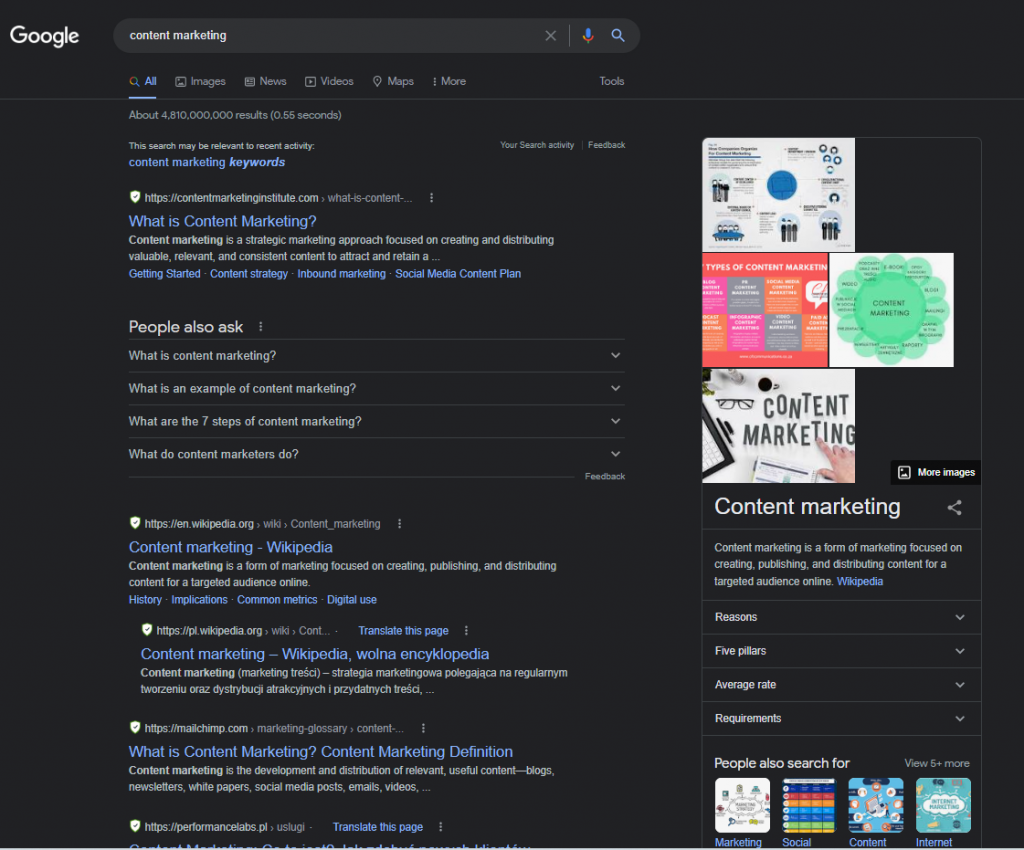
- Evaluate the intent the keyword carries. Search intent is the reason why a person is looking for something on Google or some other search engine. There are four search intents (according to Ahrefs): informational, navigational, transactional, and commercial. So, when thinking about making a keyword into a blog post topic, consider how the reader expects the information conveyed by this keyword to be presented to them.
As you can see, researching a topic that would bring blog traffic requires in-depth analysis. That’s why marketers invest in SEO tools, where they can do keyword research via a unified dashboard.
For instance, on SEMrush, you can check the keyword’s SV and KD, keyword variations, questions, and related keywords (can help you find long tail keywords with low KD but high SV), get SERP analysis and spot keywords your competitors rank for:
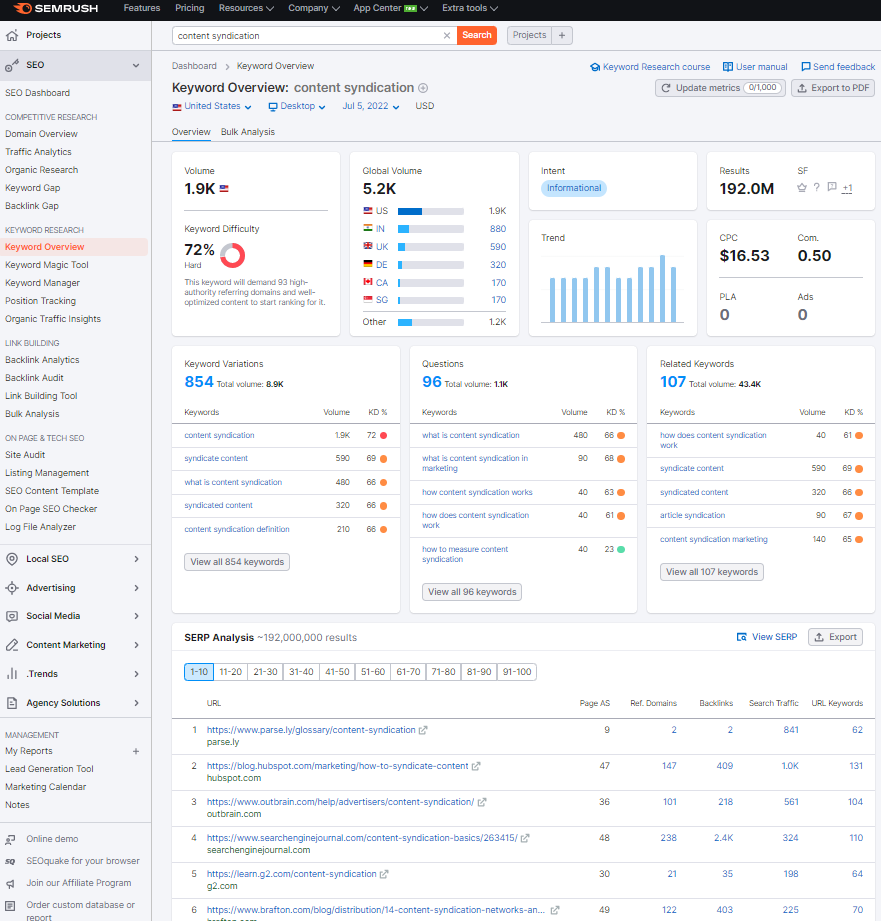
Now, let’s see what you should do next with your chosen keywords.
Step #2: Optimize your content
Once you have the list of keywords, it’s time to plan your content to place all of them strategically.
What do we mean by strategically?
The days of keyword stuffing are long gone; today, the focus goes to bringing value, even if you’re writing a blog post for the sole purpose of acquiring traffic. So, the keywords should appear in the text organically and not be an eyesore. They should bring meaning to your content rather than simply be there for traffic.
Here’s how you can achieve that effect:
- Check how your competitors structure their content. That’s why you need SERP analysis: by checking out your competitor’s content, you can study how they’ve mapped it out and where they’ve included the keywords.
- Select primary, secondary, and additional keywords. Primary keywords should go into the title, headings, and subheadings (H2, H3), and secondary and additional keywords should be spread throughout the text to support the main idea.
- Include primary keywords in meta tags. The meta title and meta description appear in the preview of your blog article in Google search results.
- Use keywords in the first 200 words of your article. There’s a standard practice of inserting the primary keyword in the first paragraph of the introduction (only if it doesn’t look spammy), but don’t overstuff the beginning of your article with search terms just for the sake of better ranks and more traffic – it doesn’t work like that.
Overall, the main recommendation is to use keywords naturally. Google is against keyword stuffing, and that includes the title tags and alt text. So, analyze your keyword list and consider how to incorporate all search terms organically. Based on that, build your content structure.
By the way, tools like Ahrefs and SEMrush can be of great help to assist you with optimizing your blog content. Apart from that, if you’re using WordPress as your CMS, set up the Yoast SEO plugin for quick blog post optimization.
Now, off to our next tip on improving the visibility of your blog.
Way #2: Write Guest Posts
Link building is an off-page SEO tactic and is one of the core ranking factors (even if Google denies it), as it can impact the ranking of your blog content and the website authority. One of the effective ways to build links back to your blog is guest blogging, and it’s a quite popular technique, take a look.
According to the statistics by Ahrefs:
- 50% of bloggers contact ten or fewer people monthly in search of guest blogging opportunities.
- 60% of bloggers write up to five guest posts a month.
- 93% of editors plan to increase the volume of published guest posts in the near future.
If you’re interested in getting into this strategy, here are three steps to follow.
Step #1: Make a list of relevant blogs
You want to start with creating a catalog of websites that accept guest posts. You can do it in various ways, one of which is using Google search operators – keywords, which websites that allow guest posting add to their Guidelines page for more people to find them.
Here’s the list of the search operators you can use:

As you can see, these are search queries indicating an interest in a guest posting opportunity, and they should lead you right to the web pages of sites that have such opportunities:
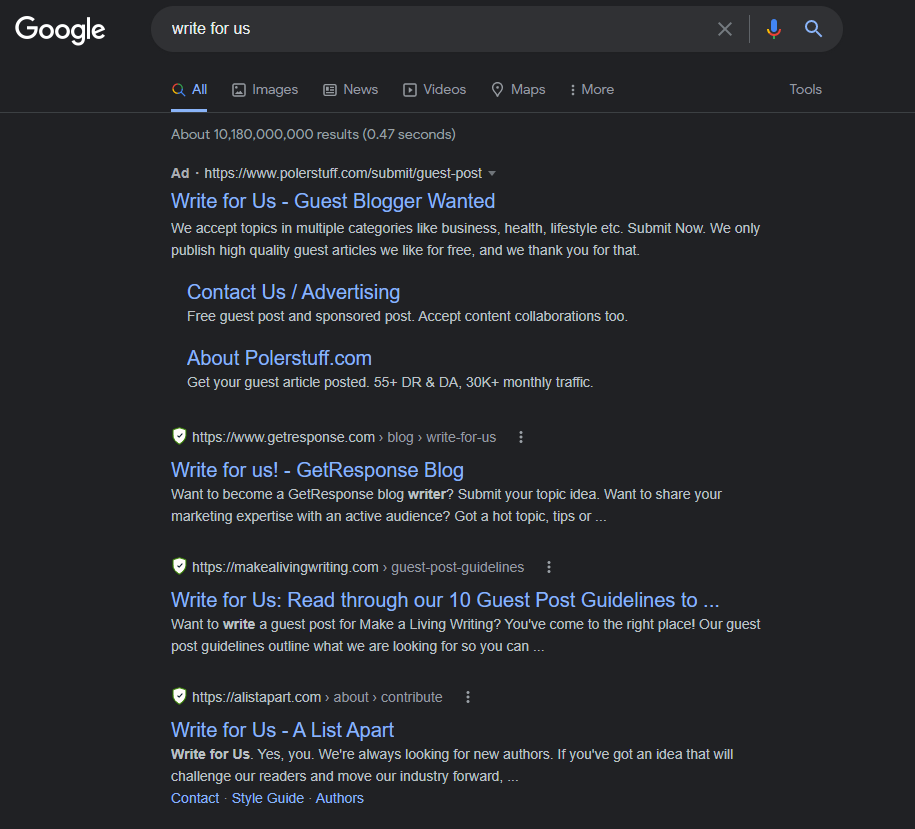
However, note the word relevant in the title of this section – it’s important to search for blogs that come from the same niche as yours. Otherwise, you risk getting a bunch of irrelevant links back to your site.
How can you find such blogs?
Simply type in one of the search operators mentioned above and add ‘+ [name of your niche]’. Google will adjust the search results accordingly.
Step #2: Contact the site owners
Let’s say you found the website you’d like to write for. Your next move would be to contact its owner, the editor, or the person responsible for content or partnerships.
Usually, websites have contact signup forms on the landing pages with guest posting opportunities, which you can fill in and wait for the response. Here’s a signup form example used to contact website owners:

What if you don’t get an answer?
In this case, you can do some digging and reach out to the website owner or blog editor via LinkedIn. However, personalize your outreach – go through their page, see the latest posts they’ve made, study their interests. If you have common ground with them, the chances are that they won’t ignore your message and might be more inclined to agree to your guest post request.
Step #3: Write an awesome post
Finally, when you have the opportunity, it’s time to prove yourself and write a top-notch guest post.
Here, there are a few things you need to keep in mind. First of all, even though you’re writing primarily to get a backlink, this guest post also represents you as an educator in your industry and will work for your authority. So, you really need to do great research and deliver valuable insights in your blog post.
Apart from that, you should also remember that your guest article should fit the blog well. That’s why it’s important to research the website you’re writing for and make sure your final post corresponds to the goal and values of the blog hosting your article.
Next, let’s see how social media can improve your blog’s visibility.
Way #3: Share Your Content on Social Media
Social media networks can do wonders to give online exposure to your blog and drive more traffic to it. It’s a so-called organic social traffic, which you can spot in your Google Analytics report:
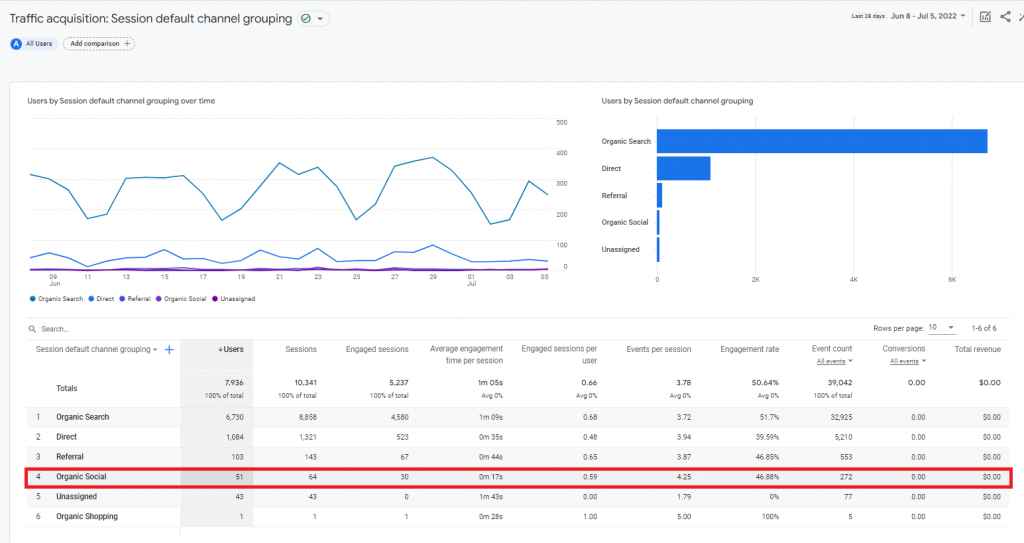
The main trick of promoting your blog articles on social media is to customize your message to each social platform. Aside from that, you’ll also need to study your audience on each platform you’re using to make sure your post reaches as many people as possible. We’ve discussed how to do it in our recent article on social media marketing tips.
By customizing, we mean that you shouldn’t reuse the same visuals or post captions to spread the word about your new blog post. Instead, come up with something that would fit in with other content on a given social network. You’d also need to pick the content type your followers prefer the most.
The following example from PickUpLimes perfectly demonstrates this approach in action. PickUpLimes is a YouTube channel created by Sadia Badiei, a certified dietitian. She also has a blog where she uploads all the recipes. Since most of her Instagram audience also watches her on YouTube, she promotes her blog post recipes on her Instagram page using short Reels to show recipes in motion:

As you can see, there is no link to the recipe on her blog in the image description, which is a practice influencers use to improve user experience and not clutter the captions (the character count is limited, too). Instead, you need to go to the page bio, where you can click the link that will redirect you to the website.
If most of your target audience follows you on Facebook, you can use the same approach – pick your audience’s preferred content type and use it to promote your blog post. You can find this data in Facebook Insights:

If you’re a B2B company, you can also try promoting your content on LinkedIn and Twitter. By the way, a little tip – if you have no time to tailor each post to given social media platforms, consider social media management tools – they have marketing automation features that can do it for you.
Now, let’s see how email marketing can help you boost awareness and drive more visits to your blog.
Way #4: Leverage Email Marketing
Email marketing is a very versatile strategy, and one way to use it is to promote your blog. The most convenient solution, in this case, would be to run newsletters containing a selection of your latest articles and share them with your email list.
Would it really attract attention?
Stats say you don’t have to worry about it. PostUp investigated different use cases, and here’s what they’ve found:
- The average newsletter open rate is 22%, but it can get higher. For instance, The Washington Post enjoys a 30% open rate, and 1440 Media boasts a 50%+ open rate, which is incredible.
- Vanity Fair’s newsletter subscribers read two times more content than visitors from other channels.
- Vox’s newsletter readers spend 110 seconds on the website on average, while others stay for no longer than 40 seconds.
You might be thinking – the email newsletters of these brands must be really outstanding if they bring so many open rates and engagement. However, if we take The Washington Post, for instance, its newsletter doesn’t look special – it’s a simple news roundup:

The trick here is to personalize the selection of articles (or blog posts, in our case) to fit the target audience’s interests. This directly impacts the open rates, click-through rates, bounce rate, and other engagement metrics, ultimately influencing the amount of traffic delivered to your blog through email marketing.
We’ve written about newsletter personalization and other tips in our email newsletter best practices article, make sure to check it out.
Next, let’s see why you should add influencer partnerships to your blogging strategy.
Way #5: Engage with Other Bloggers
Similar to guest blogging, you can also engage with other bloggers and entrepreneurs and offer a mutual promotion to grow your audience and bring more traffic to your website. It can be a blogging or podcast influencer from your niche or a small business owner with a popular blog.
Of course, you can suggest an option to publish a guest post on your website in exchange for a link back to one of your blog posts. However, it’s not the only way to run such a partnership.
Here are some more ideas on how to engage with other bloggers to get your site noticed:
- Insert links to their blog posts in your content. Pick up relevant guides, case studies, or articles with tips you deem useful for your readers and link back to them. Then, get in touch with the blogger who authored these posts and let them know you’ve linked to their content. The goal of this interaction is to simply build valuable connections that will eventually help you grow your blog.
- Invest in expert roundup posts. Making such content involves contacting each expert and asking them for their opinion on a certain topic. Digital Olympus made such a post interviewing over 40 experts on the best ways of acquiring traffic. Since you’ll be talking to each expert directly, you’ll build a relationship with them, which could create an opportunity to expose your blog to new audiences.
- Search for relevant LinkedIn or Facebook groups. Members of such groups often look for mutual promotions and opportunities to grow their websites. For instance, a group called B2B Bloggers Boost on Facebook helps B2B businesses find the guest posting and link building opportunities within their niche.
- Share other bloggers’ content on social media. This will let them know directly that you show interest in their activity and are interested in promoting it. You can often see this tactic on LinkedIn, where people like and share each other’s posts. You can also leave a comment under the publication of a person you want to reach out to and thus engage in a conversation with them.
Note, however, that it’s important to limit your connections to your industry or related niches. It doesn’t make sense to start building a partnership with a person from the home development niche if your blog is about beauty and self-care. Remember, if you want your blog to get noticed, you want to reach out to an audience that has an interest in what you have to offer.
Let’s see what’s next on our list of tips.
Way #6: Never Compromise on Quality
It’s a given that great content is also highly shareable. When people see great value in your content, especially when it can redefine what’s been known by your industry before, it can bring you immense exposure.
But what are the characteristics of quality content?
We’ve already mentioned one – value, which means your content should be unique and helpful, solving a certain pain point of the target reader. Consequently, the content should be fulfilling, meaning that the final result it brings should fully satisfy the target audience’s expectations.
Here are some more characteristics of the best content:
- Engaging – it should present facts and findings in a way that grabs the reader’s attention.
- Storytelling – good content comes in the form of a story relatable to the readership.
- Consistent – the flow in the content should be logical and understandable to the target audience.
- Readable – your content should be understandable to readers with different backgrounds, so it should avoid niche jargon and industry lingo.
We could also add that good content always represents the brand and its values, no matter whether we’re talking about a company or a personal brand. It should be written in the style characteristic of your brand; this way, it will be more noticeable and recognizable.
Ultimately, the content’s quality is your signature card. So, no matter whether you’re creating content for your own blog or for a guest post, you should never compromise on its quality, as it will impact your reputation.
Way #7 Leverage Content Syndication
Suppose you have a really great blog post. Maybe it’s a case study or original research that brings unique insights to the table? Whatever it is, you need to tell the world about it, and content syndication can help you with that.
Content syndication is an outbound marketing strategy that involves republishing a piece of content on different online resources, i.e., content syndication platforms, which can be free, paid, and owned.
To choose among the three forms of content syndication mentioned above, you need to understand what goal you’re trying to achieve. If the goal is to simply raise awareness, and the traffic isn’t much of a concern, you can ask paid platforms to distribute your content. They will place your content in so-called chumboxes – “Recommended for You” sections at the bottom of news websites.
If organic traffic is your primary goal, it’s best to opt for free or owned platforms. With free content syndication websites, you reach out to websites and pitch your content to them. Owned content syndication presupposed creating an account on specific websites, where you can publish your article, research piece, etc.
Many companies do content syndication on owned platforms, such as Medium. To indicate that the content is syndicated, they add the Originally published on [Name of the website] note, like in the example below:

With content syndication, a major concern is creating duplicate content, which Google frowns upon. However, if you add more internal links to the original resource, a noindex tag to the page, and the rel=canonical tag to the page’s URL, you won’t face any issues.
Way #8: Don’t Forget About the Physical World
So far, all of the methods we’ve talked about are on the digital marketing side, and you can try them out without having to leave your house. But what about traditional marketing? How can it help get your blog noticed and increase traffic coming to it?
You can try some good old marketing techniques, however, not all of them would be a good fit. For example, it’s counterproductive to create a banner with a link to your blog to try and get more people to check it out. It’s also money down the drain to run TV ads for this purpose.
So, which traditional marketing tactics would work to promote your blog?
Participating in offline events would undoubtedly help you grow connections and make people interested in your website. If you participate as a speaker, you can promote your blog during the presentation, and if you’re attending, you can give out your business cards with your website’s name written on them.
Events activate the power of word-of-mouth marketing. If you get a person interested in your corporate blog, they might think of you the next time they launch a marketing campaign and need promotion. Then, you can offer mutual partnership and also get some traffic to your website. So, with some effort, you not only can boost awareness but also drive more visits to your blog.
By the way, if you’re working in the digital marketing niche and would like to attend some conferences, we have the list of relevant events for 2022 here.
Now, let’s return to the inbound strategies and discuss how posting frequency impacts the blog’s visibility.
Way #9: Write More Often
Consistency is key to everything. When you post articles on your blog regularly, it contributes to its growth and helps build authority over time. However, growth won’t happen if you post four articles a month – that’s simply not enough to get it noticed.
So, the hint is clear – you need to make blog posts more often. But what is the ideal frequency?
Let’s look at some data. According to Hubspot, the best posting frequency for small blogs is 3-4 new posts a week. If you have a larger blog, the best posting frequency is 4-5 blog posts a week, and that includes updating content you published earlier. These are the ideal numbers if your goal is to increase traffic acquisition.
If we’re talking about boosting brand awareness, one or two posts a week would be enough for small blogs, while large blogs need to craft three to four articles per week.
Why so often?
Let us explain. If you own a big blog with a lot of content, you need to maintain consistency since your blog has already been picked up by Google and is recognizable among your readers. So, to get lots of traffic and awareness, you need to gradually gain traction, post more new content and update older articles to remain visible in the SERPs.
As for the younger blogs, it’s important here to start building authority in the niche you’re covering with your articles. In SEO terms, it’s called semantics – there should be enough articles within the same niche for the organic search traffic to start building up. Don’t rush it, though – in some cases (e.g., if your blog is standalone and doesn’t belong to a brand), it might take up to three months for your blog posts to start ranking. So, be patient and keep working hard on your content.
But what if you want to speed up the results? Paid advertising might help, so let’s discuss how you can use it.
Way #10: Don’t Forget About Paid Advertising
It’s not as common to run PPC ads for blogs compared to e-commerce online businesses, but you can see such online ads occasionally. The most common way is to advertise via Google Ads and have some of your best articles appear at the top of the SERPs. For instance, SEMrush runs an ad on Google to promote its beginner’s guide to SEO:
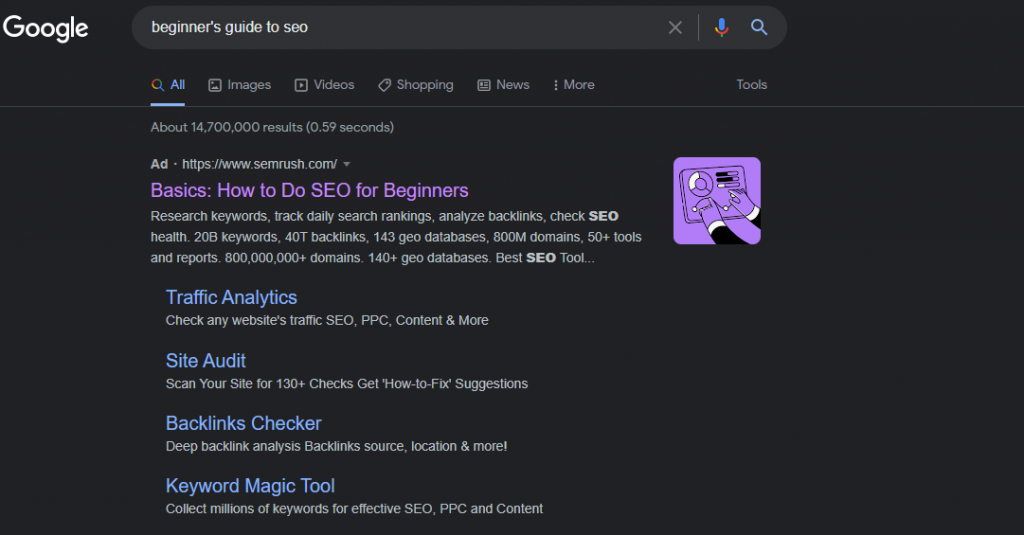
You might be wondering – how viable is such an investment? Wouldn’t it be enough just to promote your blog using all the methods mentioned above?
We get your point – PPC ads can be pretty expensive. According to WordStream’s research, the most expensive cost per click (CPC) on Google can go up to $50 (the price depends on the keywords you select for your ad). The average cost per mille (CPM) on Google is around $38.
However, if you set up a proper advertising campaign, it will effectively spread the word among the right audiences and familiarize them with your blog. According to statistics, brand awareness can increase by 80% through Google paid ads. Apart from that, if you’re trying to make money out of your blog and need more traffic to it, this traffic will yield 50% more conversions than organic promotions.
So, when you can, by all means, invest in paid advertising. It will be a temporary campaign, but the results it can bring can change the performance of your blog.
Let’s see what’s next on our list.
Way #11: Use Social Bookmarking Sites
Social bookmarking is a service allowing users to add, organize, share, and edit bookmarks of online documents. These websites are usually communities where people spread valuable information among one another, and that’s why you can tap into social bookmarking to get your blog noticed.
Here’s the list of the five most popular social bookmarking platforms:
- Digg – a free tool where you can bookmark, comment, and publish your own content.
- Evernote – mostly known as a note taking app, this resource also allows bookmarking and archiving.
- Pinterest – known as a social media platform with bookmarking options. You can use it to share infographics, templates, and other visuals.
- Scoop.it – a platform that allows you to research, publish, and share content with others.
- Medium – you probably know it for content syndication opportunities, but it’s also possible to bookmark resources on this website.
By using one of these resources, you can add a bookmark of your latest research with a short annotation of it. Other people using the social bookmarking service can leave a blog comment and join a discussion board. They will also have to click the link to go directly to your website to read the whole content piece, thus bringing you additional traffic.
So, what do you need to do to promote your blog on bookmarking websites the right way?
First of all, you need to research the platforms and find the one that has the readership for your content. You might need to go for a more niche website, such as GrowthHackers, to get more relevant traffic.
Next, it’s all about optimizing your content. Work on the headlines to make them more catchy and add a featured image (make sure it’s branded, we’re working on blog awareness, too). Afterwards, you can also write a short description (about 150 characters) as a synopsis of your blog post. It would also help to incorporate a social sharing button in your blog so people could share it faster.
Now, let’s talk about our last tip or how you can use online forums to promote your blog.
Way #12: Mention Your Blog in Online Forums
Last but not least, you can’t miss the opportunity to advertise your blog on online forums. Many people use these websites to share information and discuss it – Reddit, for instance, had over 48 million users back in 2021 in the US alone.
So, by promoting your blog posts on websites like Reddit and Quora, you can raise awareness and significantly grow your target audience. However, these forums (and many others, too) don’t like direct promotions. You can even get banned if other users notice a pattern in your comments and report you to the admins.
So, how do you do blog promotions on forums the right way?
Here are some tips:
- Look for relevant groups and subreddits. Remember – you want to connect to the people who come from your niche and are interested in topics related to it.
- Join and observe for some time. For the first several weeks, try not to engage in too many group activities. Instead, observe the topics people discuss and how they normally perceive when someone recommends (read promotes) content on their blog.
- Be helpful. Don’t just upload a link and a short description of your content piece. Instead, try to incorporate it into short guides and tutorials related to your content’s topic. Also, use other resources to introduce your point of view objectively.
You should keep in mind that forums primarily exist to help and guide others. Thus, as a member, you should search for opportunities to be helpful with your content, not force it on everyone.
Over to You
We’re done with our tips on how to get your blog noticed and increase traffic. As you can see, some ways are more involved than others, but with the right approach, you can tailor them to your needs and drive great results.
Let’s quickly recap everything we mentioned:
- Invest in search engine optimization
- Write guest posts
- Share your content on social media
- Try email marketing
- Collaborate with new bloggers and industry influencers
- Watch out for the quality of your content
- Leverage content syndication
- Promote your blog at events and conferences
- Write consistently and frequently
- Try paid advertising
- Tap into social bookmarking websites
- Promote your content on online forums
Hopefully, our blogging tips will help you get your content noticed and bring more traffic to it.
Interested in more articles like this? Make sure to check out our blog – we have many guides and useful content with tips there.

Mariia is a content strategist and editor at Digital Marketer’s World. She is passionate about educating others on all things marketing and believes in the power of the written word.
